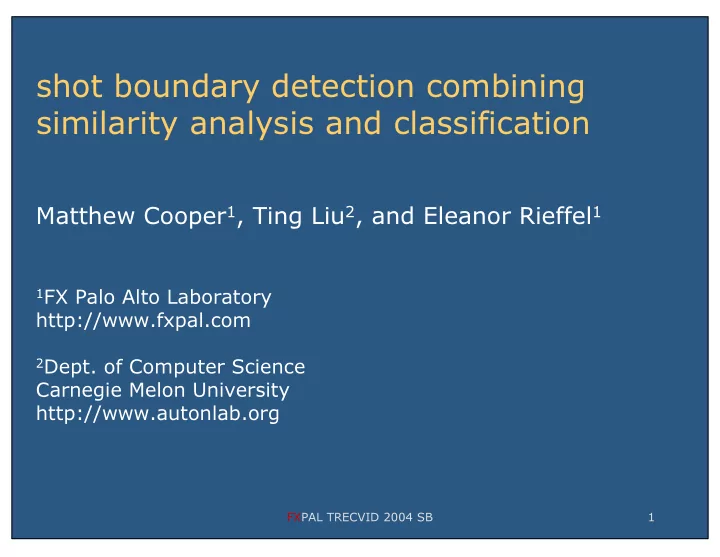

shot boundary detection combining similarity analysis and classification Matthew Cooper 1 , Ting Liu 2 , and Eleanor Rieffel 1 1 FX Palo Alto Laboratory http://www.fxpal.com 2 Dept. of Computer Science Carnegie Melon University http://www.autonlab.org FXPAL TRECVID 2004 SB 1
traditional video segmentation S E V G Low-level Local I Peak M Feature Novelty D E Detection Extraction Analysis E N T O S what’s working and what’s not? � features are YUV histograms (block and global) � replace ad hoc peak detection with supervised � classification as in [Qi, et al., 2003] Y. Qi, A. Hauptman, T.Liu. Supervised Classification for Video Shot Segmentation. In Proc. of IEEE International Conference on Multimedia & Expo , 2003. FXPAL TRECVID 2004 SB 2
reformulating segmentation S V E Low-level Local Boundary / G I M Feature Novelty Non-boundary D E Extraction Analysis Classification E N O T S L F F N O E E O W A A Pairwise Linear V T T E L similarity kernel U U L E comparison(s) correlation R R T V E E Y E S S L FXPAL TRECVID 2004 SB 3
inter-frame similarity analysis concatenate YUV � histogram features construct L1 similarity � matrix: S FXPAL TRECVID 2004 SB 4
novelty via kernel correlation scale-space kernel linearly � combines adjacent frame comparisons more generally: � S FXPAL TRECVID 2004 SB 5
related work: dissimilarity kernels scale-space (SS) kernel weights � only adjacent inter-frame similarities [e.g. Witkin, 1984] diagonal cross-similarity (DCS) � kernel weights inter-frame similarity of pairs L frames apart [Pye et al., 1998; Pickering et al., TRECVIDs] row (ROW) kernel compares � current frame to each frame in local neighborhood [Qi, et al., 2003] FXPAL TRECVID 2004 SB 6
dissimilarity kernels cross similarity (CS) kernel is � matched filter for ideal dissimilarity boundary full similarity (FS) kernel � penalizes within-segment dissimilarity [Cooper and Foote, ICIP 2001] FXPAL TRECVID 2004 SB 7
input features for classification kernel-based features: concatenate frame- � indexed kernel correlations ν L (n) for L=2,3,4,5, for both global histogram similarity and block histogram similarity raw similarity features: concatenate all raw � similarity comparisons that contribute to kernel correlation for L=5 (without linearly combining them) FXPAL TRECVID 2004 SB 8
experimental setup efficient exact kNN classifier provided by T. Liu and � A. Moore at CMU (http://www.autonlab.org) ball-tree implementation ~ 10 times speedups over � naïve kNN for details, see [Liu, Moore, Gray, NIPS 2003] � TRECVID 2002 test set for cut boundary detection � almost 6 hours of broadcast news data � manual ground truth, 1466 cut boundaries � medians from TV02: recall = 0.86, precision = 0.84 � hold-one-out cross validation, k = 11 � FXPAL TRECVID 2004 SB 9
comparative results FS similarity features � provide most information and achieve best overall performance FXPAL TRECVID 2004 SB 10
setup for SB04 to extend to cut and gradual detection, we follow two-step � binary classification approach in [Qi, et al., 2003] Cut Feature vector Gradual (pair-wise Transition similarity data) Non-Cut Normal Classification unlike prior work no smoothing of classifier outputs, no � motion, flash, etc. efficient exact kNN classifier k = 11 � 8 CNN and ABC videos from SB03 test set � hold-one-out cross validation � FXPAL TRECVID 2004 SB 11
training – varying the similarity measure FS pairwise similarity features used � 8 ABC and CNN videos in SB03 test set used for training � testing similarity measures � testing different lag L=5, 10 � random projection for dimension reduction for L=10 � FXPAL TRECVID 2004 SB 12
comparing similarity measures 1 2 FXPAL TRECVID 2004 SB 13
training – varying L L=10 implies FS feature dimensionality is d=380 � problem of fast kNN � significant speed-up when d is small: O(1) ~ O(dNlogN) � little speed-up when d is large: O(dN 2 ) � random projection � easy to implement: O (d’dN) � FXPAL TRECVID 2004 SB 14
varying L for fixed featured dimensionality FXPAL TRECVID 2004 SB 15
SB04 systems training data consists of 8 ABC, CNN videos � from SB03 set 90% of non-boundary frames discarded � k = 11 � 0 k ≤ κ ≤ sensitivity determined by � post-processing to avoid spurious boundaries � in local temporal neighborhood FXPAL TRECVID 2004 SB 16
R P F Avg 0.831 0.762 0.776 Cut Results Best 0.920 0.951 0.935 <FXPAL> 0.903 0.940 0.921 FXPAL TRECVID 2004 SB 17
R P F Avg 0.503 0.578 0.565 gradual results Best 0.846 0.775 0.8089 <FXPAL> 0.756 0.789 0.769 FXPAL TRECVID 2004 SB 18
R P F Avg 0.7255 0.727 0.709 mean results Best 0.884 0.896 0.890 <FXPAL> 0.856 0.891 0.872 FXPAL TRECVID 2004 SB 19
time complexity SysID Decode/Extract kNN PostProcess TOTAL Ratio to Real Time FS05_04 24882.350 20183.000 7.800 45073.150 2.087 FS05_05 24882.350 20183.000 7.789 45073.139 2.087 FS05_06 24882.350 20183.000 7.831 45073.181 2.087 FS05_07 24882.350 20183.000 7.831 45073.181 2.087 FS05_08 24882.350 20183.000 7.870 45073.220 2.087 FS10_04 24882.350 21825.000 7.811 46715.161 2.163 FS10_05 24882.350 21825.000 7.793 46715.143 2.163 FS10_06 24882.350 21825.000 7.809 46715.159 2.163 FS10_07 24882.350 21825.000 7.801 46715.151 2.163 FS10_08 24882.350 21825.000 7.830 46715.180 2.163 1 decode run includes histogram extraction (code never � optimized) for all SysIDs 2 classification runs correspond to 10 SysIDs � all times for all 12 videos � FXPAL TRECVID 2004 SB 20
conclusions many segmentation approaches can be � formulated within the framework of inter-frame similarity analysis and linear kernel correlation non-parametric supervised classification is � effective for media segmentation very general framework � thanks to Andrew Moore at CMU � for more information: cooper@fxpal.com � FXPAL TRECVID 2004 SB 21
Recommend
More recommend